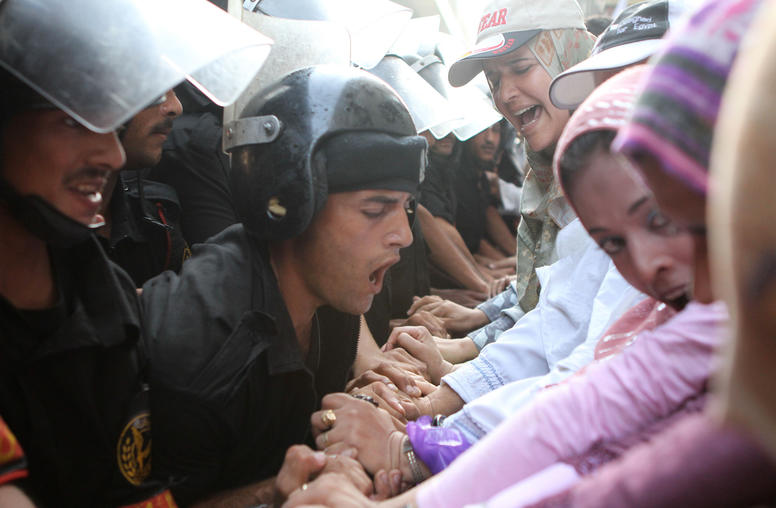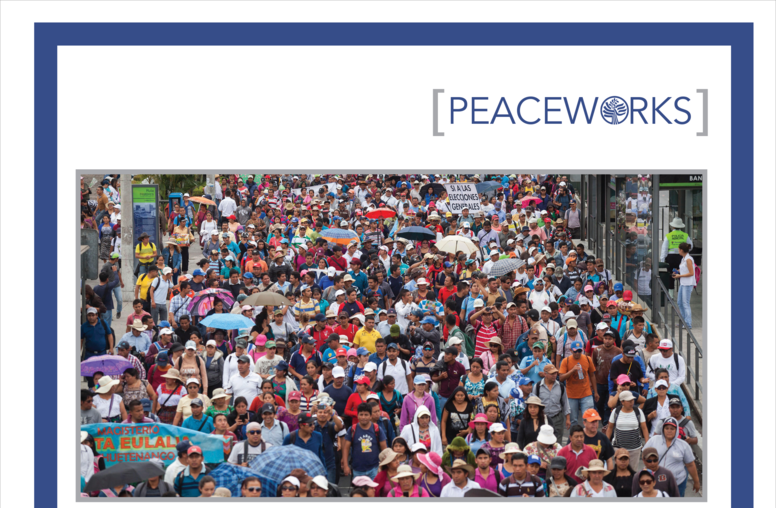What is the Synergizing Nonviolent Action and Peacebuilding (SNAP) action guide?
An Action Guide
The Synergizing Nonviolent Action and Peacebuilding (SNAP) guide provides a strategic framework for activists, peacebuilders, and organizers working to transform violent conflict and advance a just peace. It demonstrates how nonviolent action and peacebuilding approaches can be used together synergistically to mobilize communities, address power imbalances and conflict drivers, and support inclusive, participatory peace processes.
The guide, also available in Arabic, Burmese, and Spanish, is for trainers, facilitators, and other practitioners serving the many organizers, activists, mediators, negotiators, and peacebuilders who want to learn more about how to integrate nonviolent action and peacebuilding strategies in their work.
The impetus behind SNAP comes from case study research that highlights how grassroots activists, organizers, and peacebuilders engaged in nonviolent action and peacebuilding can use approaches from both fields together to strategically plan and more effectively prevent violence, address grievances, and advance justice. While scholars such as Adam Curle,1 John Paul Lederach,2 Lisa Schirch,3 Veronique Dudouet4 and Anthony Wanis-St. John5 have explored synergies between the two fields for decades, the SNAP guide is one of the first to offer practical modules and exercises meant to help practitioners operationalize the combined approach at the grassroots.
It is also intended to provide organizations that support field-based peacebuilding, human rights, and conflict transformation with new tools and frameworks to guide their work. The guide provides users with the opportunity to explore the synergy between nonviolent action and peacebuilding approaches to develop the capacity and skills necessary to assess conflict, build coalitions, mobilize constituencies, balance power, and consolidate gains as they work to address injustices and build inclusive peace processes.
As a student and a budding activist, it helps me to understand more about nonviolent action, tactics that can be used, and how peacebuilding can be woven throughout.
Boycotts or negotiations? Pressure or engagement? Which approaches, and in what sequence, are most effective for building a just and sustainable peace?
In 1971, feminist nonviolent activist Barbara Deming wrote about “revolution and equilibrium,” asserting that activists needed “two hands of nonviolence”—one hand with a palm facing out to say, “stop the injustice!” and another offered as a handshake. Building just, inclusive, and peaceful societies requires people who are willing and able to use a wide variety of approaches, including direct action, relationship building, volunteer mobilization, dialogue, and negotiation. However, these activities are sometimes seen as separate or incompatible.
Grassroots activists may know how to engage in protests and other forms of nonviolent direct action, but they may have less experience facilitating a delicate meeting featuring diverse groups and opinions. Peacebuilders may excel at dialogue or negotiation, but they may get stuck when one group has more power than another, making it difficult to reach a just resolution. Each approach has its own history, community of practice, literature, and education and training programs.
The SNAP action guide seeks to build bridges between peacebuilding and nonviolent action practitioners and illustrate how the most strategic and effective methods from both fields can reinforce one another to advance justice, promote human rights, and build sustainable peace.
Interested in learning more about the guide or strategic planning and skills-building workshops based on the guide? Contact snap@usip.org.

Only a few months ago Nicaragua was a spectator to the turmoil in Guatemala, Honduras and El Salvador that has led to a massive exodus of families seeking refuge by traveling north. Sadly because of the current tumult in Nicaragua, a new refugee crisis could be on the way. To prevent further escalation and increase the chances of achieving a just peace, the opposition and the Catholic Church should loudly and strategically embrace nonviolent discipline.

The United Nations has declared a priority this year to unify and strengthen its work in building peace—and U.N. bodies will meet in the next two months to advance that change. U.N. leaders have acknowledged that a vital element in peacebuilding is nonviolent, grassroots movements that can prevent violent conflict by providing ways for people to constructively address grievances, seek rights and advance justice. But as the United Nations aims to more efficiently promote peace, how prepared is it to actually work with the nonviolent grassroots movements that have proven to be peacebuilding’s most effective tool?

The Catholic Church, with its 1.2 billion adherents worldwide, has been pivotal in some of the most significant nonviolent struggles in modern history. Many will recall the iconic image of Filipino religious sisters confronting military forces and a kleptocratic dictatorship of Ferdinand Marcos in prayerful resistance during the 1986 “people power” revolution. Today, Filipino religious leaders, facing another violent dictator, Rodrigo Duterte, once again are the leading face of nonviolent resistance. The Vatican is discussing these and other examples of powerful nonviolent movements as it rethinks its long-held doctrine of “just war.”

In 2011, the world watched millions of Egyptians rally peacefully to force the resignation of their authoritarian president, Hosni Mubarak. “When Mubarak stepped down … we realized we actually had power,” recalled Abdallah Hendawy, a prominent activist. But, having won a victory in the streets, Egypt’s pro-democracy activists found they were ill-prepared for the negotiating table and the collaboration needed—among themselves and with Egypt’s politically powerful military—to consolidate their gains.

Reviewing the literature on negotiation and civil resistance, this report examines the current divide between the two and digs deeper to identify the fundamental convergences. It builds on these findings to illustrate why negotiations and negotiation concepts are essential to the success of civil resistance campaigns. Using historical examples, it then examines the dynamics of negotiation in the context of these strategic domains.
It was a great workshop, I particularly enjoyed having the opportunity to share with individuals from different types of organizations (activists, academics, practitioners) representing work around the world.

Event Highlight

Event Highlight

ဤလမ်းညွှန်စာအုပ်သည် ပဋိပက္ခ အသွင်ပြောင်းလဲခြင်း သို့ ဦးတည်ရာတွင်နည်းလမ်းများအား မဟာဗျူဟာကျကျ ထိထိရောက်ရောက် အသုံးပြုနိုင် စေရန်ငြိမ်းချမ်းရေး တည်ဆောက်သူများ နှင့် အကြမ်းမဖက်လှုပ်ရှားမှု ဖော်ဆောင်သူများ အကြား ချိတ်ဆက်ရန် ကြိုးပမ်းခြင်းဖြစ်သည်။ ၎င်းသည် တရားမျှတမှုနှင့် ရေရှည်တည်မြဲသော ငြိမ်းချမ်းရေးကိုမြှင့်တင်ရန်အ ပြန်အလှန်ပြောဆိုခြင်း၊ တိုက်ရိုက်လုပ်ဆောင်မှုများ နှင့် နည်းလမ်းများကို ပေါင်းစပ် အသုံးချနိုင်ကြောင်း ပြသခြင်းဖြစ်သည်။ ဤလမ်းညွှန်စာအုပ်သည် ၎င်းတို့၏လုပ်ငန်းခွင်တွင် အကြမ်းမဖက် လှုပ်ရှားမှုနှင့် ငြိမ်းချမ်းရေး တည်ဆောက်ခြင်း နည်းလမ်းများအား မည်သို့ ပေါင်းစပ်အသုံးပြုရမည်ကို လေ့လာလိုသည့် စီစဉ်သူများ ၊ စည်းရုံးရေးမှူးများ၊ တက်ကြွလှုပ်ရှားသူများ ၊ ကြားဝင် ဖျန်ဖြေသူများ၊ ကြားဝင် ညှိနှိုင်းသူများ နှင့် ငြိမ်းချမ်းရေးတည်ဆောက်သူများအား ပံ့ပိုးပေးနေသော သင်တန်းဆရာများ ၊ ပံ့ပိုးပေးသူများ နှင့် အခြားလက်တွေ့ ကျင့်သုံးသူများအတွက်ဖြစ်သည်။

يسعى هذا الدّليل إلى إقامة جسور تواصل بين العاملين في مجال بناء السّلام من جهة والناشطين في مجالات التّحرّك غير العنيف من جهة أخرى. ويستعرض أساليب العمل المتاحة في كلا المجالين بصورةٍ إستراتيجيّةٍ وفعّالةٍ للمساهمة في تحويل النزاع. ويُبيِّن الدّليل طريقة تحقيق التّضافر بين الحوار ومهارات التّحرّك المباشر والمقاربات من أجل خدمة العدالة والسّلام المستدامين. أعدّ هذا الدّليل ليوضع بتصرّف المدرّبين والمُيسِّرين وسائر الأشخاص المتعاملين مع المنظمات والناشطين والوسطاء والمفاوضين وبناة السّلام الذين يرغبون في معرفة المزيد بشأن طريقة الدّمج بين إستراتيجيّات التّحرّك غير العنيف وبناء السّلام في عملهم.

Esta guía de acción busca tender puentes entre los profesionales en la construcción de la paz y la acción no violenta a fin de que se usen métodos de manera estratégica y con eficacia en el camino hacia la transformación de conflictos. Muestra cómo el diálogo, las habilidades de acción directa y los enfoques se pueden sinergizar para avanzar la justicia y la paz sostenible.

This action guide seeks to build bridges between peacebuilding and nonviolent action practitioners so that methods are used strategically and effectively on the path toward conflict transformation. It shows how dialogue, direct-action skills, and approaches can be synergized to advance justice and sustainable peace. This guide is for trainers, facilitators, and other practitioners serving the many organizers, activists, mediators, negotiators, and peacebuilders who want to learn more about how to integrate nonviolent action and peacebuilding strategies in their work.

With President Joe Biden’s presidential term ending in a few weeks, expectations for his final meeting with Chinese leader Xi Jinping were modest, especially considering the broader frictions in U.S.-China relations. Biden and Xi met on the sidelines of the Asia-Pacific Economic Cooperation summit in Peru on November 16. The meeting highlighted the importance of maintaining open communications channels to manage the two powers’ many differences.

Since Chinese leader Xi Jinping launched the Global Security Initiative (GSI) in April 2022, it has been used in China’s efforts to expand its international security role and reshape global order. Drawing on field research and discussions with regional policymakers and experts, this report looks at Beijing’s progress in implementing and operationalizing the GSI in the priority regions of mainland Southeast Asia and Central Asia, and it examines key policy implications, explaining why the initiative warrants greater attention on the part of the US policy community.

As global energy demands intensify and the urgency of addressing climate shocks mounts, the role of nuclear energy has come to the forefront of discussions for governments, businesses and those concerned about sustainable development. Just last week, the Biden administration released a plan to triple U.S. nuclear capacity by 2050. While nuclear energy promises efficiency gains and significant emissions reductions, public opinion remains divided about the tradeoffs of increased investment, the safety risks and the implications for international security. This puts the U.S. at a crossroads as it tries to navigate its role in a world with new demands for nuclear energy and heightened risks of conflict between nuclear-armed states. Such risks were highlighted this week when Russia lowered its nuclear threshold in response to new U.S. authorizations for Ukraine to use long-range weapons.

With conflicts raging in Gaza, Lebanon, Ukraine and Sudan, concerns related to the extremist group ISIS may seem overtaken by these other conflicts. After all, Iraq declared the group’s military defeat in 2017 after the territory held by the extremists was retaken by Iraqi government forces in partnership with the United States. Yet just over a month ago, U.S. and Iraqi forces conducted a joint military raid against the group, killing nine senior ISIS leaders who were hiding in the rugged Hamrin Mountains in northern Iraq. This raid comes off the heels of the UK’s domestic intelligence chief stating that the group is positioning itself as a resurgent threat. Indeed, ISIS has conducted over 150 attacks so far this year in Iraq and Syria, more than those claimed by the group in 2023.

Much has happened in Haiti over the past two weeks — none of it is reassuring. The Transitional Presidential Council (TPC) fired Prime Minister Garry Conille on November 10, after only six months in office. Moments before an interim prime minister was sworn in the next day, a U.S. commercial airliner was struck by gunfire, forcing a pause in flights to Haiti’s international airport. These developments underscore the reality facing Haiti's interim government and the immense challenges it faces in achieving a transition by February 2026, as outlined in an April 3, 2024 agreement. Given this dysfunction, Haitians and their international partners are rightly concerned that the country’s evolving political and security crisis will only further deepen.